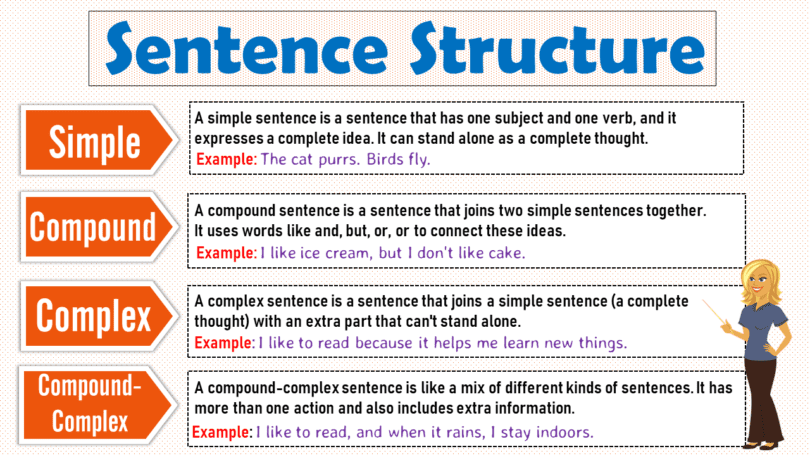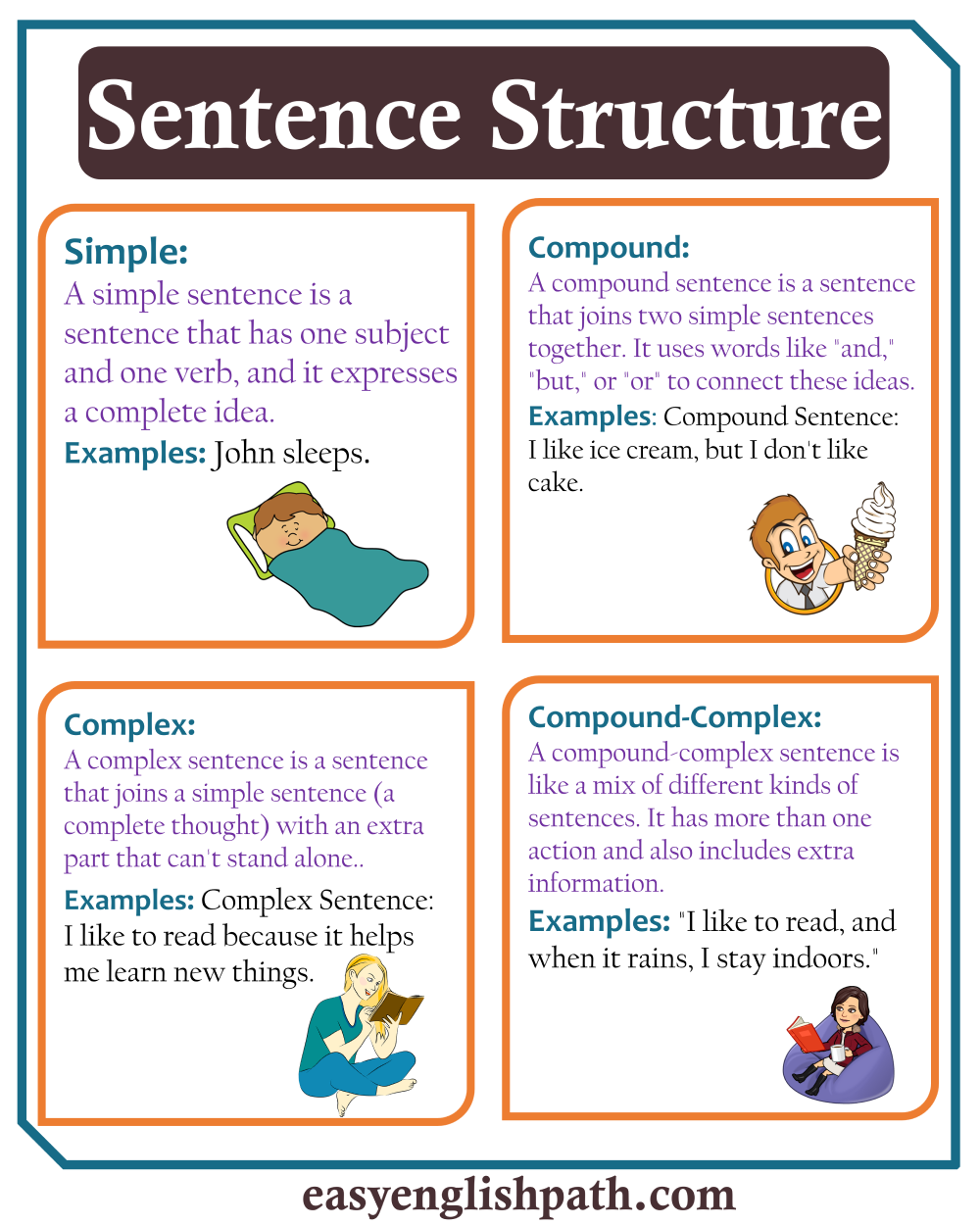Sentence structure has a great importance in English grammar. in today’s blog post, you will learn what is s sentence structure and also what are various types of sentence structures and further how to use them in writing. you will learn sentence structure types along with easy examples that will help you learn how to use and relate them to different types of sentence structure.
Types of Sentences
- Declarative Sentences:
These sentences are used to make statements or provide information about the subject.
The sun rises in the east. - Interrogative Sentences:
These sentences are used to ask questions about things or people.
What is your name? - Imperative Sentences:
These sentences are used to give commands or make requests.
Close the door, please. - Exclamatory Sentences:
These sentences are used to express strong feelings or emotions.
What a beautiful sunset!
What Do You Mean by Sentence Structure?
Sentence structure simply means the way we organize words in a sentence to make it clear and understandable. We put right words in right order so people can easily get your message.
For example, a basic structure might be:
Subject (who or what) + Verb (what they do) + Object (what it’s done to).
For instance: I (subject) love (verb) ice cream (object).
So, A sentence structure is all about arranging words in a way that can make make sense, and we do this using subjects, verbs, and objects, among other things.
Basic Part of a Sentence
Subject:
The subject is the main part of the sentence. It is used to represent the person, thing, or idea that the sentence is about. The subject can be a noun or pronoun.
Example:
Mary loves to read. ‘Mary’ in the sentence acts as a subject.
Verb:
The verb is the action or state of being in the sentence. It tells us what the subject is doing or the state it’s in.
Example:
Mary loves to read. ‘loves’ in the sentence is a verb because it tells the state of ‘Mary’.
Object:
The object is the recipient of the action. It can be a noun or pronoun that receives the action of the verb.
Example:
‘Mary loves to read. ‘to read’ in the sentence is a object.
Adjectives:
Adjectives are words that are used to describe or modify nouns. They provide more information about the subject or object.
Example:
Mary has a beautiful book. ‘beautiful’ in the sentence is an adjective. as it describes the noun ‘Mary’.
Adverbs:
Adverbs are words that are used to describe or modify verbs, adjectives, or other adverbs. They provide additional details about the action, such as how, when, or where it occurs.
Example:
“Mary reads quickly.” Quickly’ in the sentence as an adverb as it tells how ‘Mary’ reads.
Prepositional Phrases:
Prepositional phrases consist of a preposition and an object, they provide information about the relationship between nouns or pronouns in a sentence.
Example:
Mary reads books in the library. ‘in the library’ in the sentence, is a prepositional phrase.
Conjunctions:
Conjunctions are the words which are used to connect words, phrases, or clauses in a sentence. Words like ‘and, but, or, and.
Example:
Mary likes to read, and she also likes to write. here ‘And’ is a word that connects both parts of sentence.
Object Complement:
An object complement is used to describe or renames the object. They provide additional information about it.
Example:
‘Mary considers ‘Mystery at Midnight’ a thrilling novel.’ ‘a thrilling novel’ in the sentence is an object complement.
Types of Sentence Structure
- Simple Sentence
- Compound Sentence
- Complex Sentence
- Compound-Complex Sentence
1. Simple Sentence
A simple sentence has one subject and one verb, and it is used to express a complete idea. It can stand alone as a complete thought.
- The cat drinks milk from kitchen.
- John sleeps well at night.
- Birds fly in the air.
- She did not play cricket well.
2. Compound Sentence
A compound sentence is used to join two simple sentences together. the following words And. But, and Or are used to to connect these ideas.
- The cat slept peacefully, and the dog barked loudly.
- She ran to catch the bus, but it had already left.
- The rain poured heavily, yet the children played outside.
- I like ice cream, but I don’t like cake.
3. Complex Sentence
A complex sentence is used to join a simple sentence (a complete thought) with an extra part that can’t stand alone. This extra part adds more information.
- Although it was late, he continued working on his project.
- She studied hard because she wanted to pass the exam.
- After the rain stopped, they went outside to play.
- I like to read because it helps me learn new things.
4. Compound-Complex Sentence
A compound-complex sentence is a mixture of different kinds of sentences. It has more than one action and also has some extra information.
- She wanted to go to the party, but she had to finish her work first, and then she missed the bus.
- After the game ended, they celebrated their victory, but they realized they had lost their car keys.
- While Tom was studying for his exam, his sister was playing music loudly, and their parents were cooking dinner.
- I like to read, and when it rains, I stay indoors.
Sentences Structure Rules
| Subject and Predicate | Every sentence needs someone (subject) doing something (predicate). | Mary baked a cake. |
| Word Order | Put words in the right order: who’s doing what to whom. | The cat chased the mouse. |
| Agreement | Make sure the words match in number, like one cat chases, but many cats chase. | She sings beautifully. |
| Punctuation | Use dots, question marks, or exclamation marks to end sentences correctly. | What time is it? |
| Complete Thoughts | Make sure sentences make sense on their own. | I like to read mystery novels. |
| Types of Sentences | Sentences can be statements, questions, commands, or strong expressions. | Please close the door. |
| Modifiers | Use words like “big” before things and “quickly” before actions to describe them. | The tall tree swayed gently in the breeze. |
| Parallel Structure | When listing things, keep the format the same, like using verbs for each item or using nouns for each. | She enjoys hiking, swimming, and cycling. |
Sentence Structure Examples
- Cats like milk.
- Dogs bark loudly.
- Birds fly high.
- Sunflowers follow the sun.
- Children play outside.
- Apples are red.
- Water feels wet.
- I love pizza.
- She reads books.
- He runs fast.
You May Also Like






